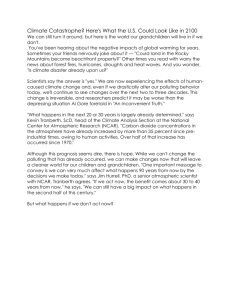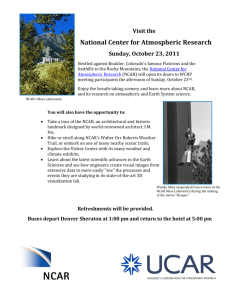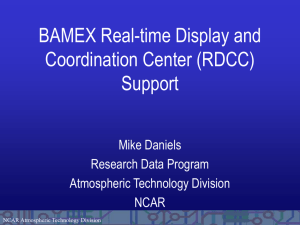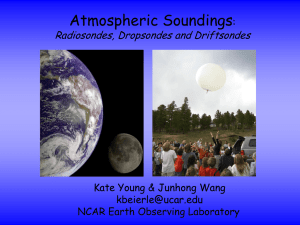Intercomparisons of Radiosonde Humidity Data and Cirrus Cloud Observations during IHOP_2002
advertisement
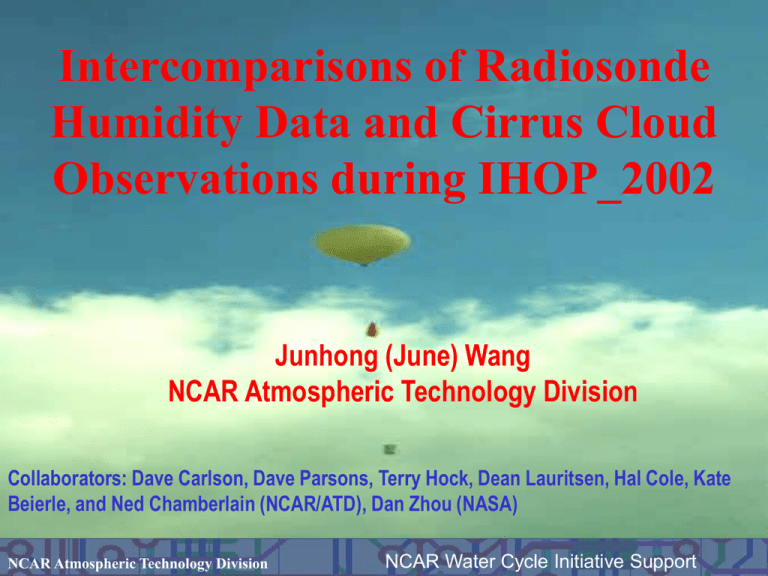
Intercomparisons of Radiosonde Humidity Data and Cirrus Cloud Observations during IHOP_2002 Junhong (June) Wang NCAR Atmospheric Technology Division Collaborators: Dave Carlson, Dave Parsons, Terry Hock, Dean Lauritsen, Hal Cole, Kate Beierle, and Ned Chamberlain (NCAR/ATD), Dan Zhou (NASA) NCAR Atmospheric Technology Division NCAR Water Cycle Initiative Support The reference radiosonde system for IHOP_2002 Swiss Radiosonde C34 •SW chilled-mirror DP hygrometer – reference humidity sensor •Carbon hygristor •Copper-constantan thermocouple •Hypsometer Reference radiosonde 400MHz transmitter GPS receiver NCAR Atmospheric Technology Division Vaisala RS80 NWS VIZ B-2 SnowWhite Chilled-mirror dewpoint hygrometer Scattering light detector Heated sensor housing Reflecting light detector Thermocouple Mirror Peltier • Accurate measurement of dew/frost point • Fast response • Detects clouds and estimates their liquid/solid water • No influences of radiation, wind and others • Needs no individual calibration and recalibration after recovered NCAR Atmospheric Technology Division RS with NWS VIZ (7) RS with Vaisala RS80H (7) and RS80A (2) RS80H v.s. RS90 NCAR Atmospheric Technology Division Comparisons between SnowWhite and Vaisala RS80-H •Vaisala RS80-H with the sensor boom cover agrees with the SW very well in the middle and lower troposphere, but has dry biases in the UT. •The TD and time-lag corrections reduce the differences but not enough. NCAR Atmospheric Technology Division Courtesy of Larry Miloshevich for correcting the sounding Comparisons between Vaisala RS80H (Norman) and RS90 (ARM-B6) WHY? •Not sampling the same air mass? No •Solar heating of RS90? No (no day/night difference) • Faster response of RS90? No •Warmer RS90 T? Not through calibration, maybe warmer humidity sensor boom. NCAR Atmospheric Technology Division Comparisons between SnowWhite and Carbon Hygristors No response Slow response NCAR Atmospheric Technology Division Summary ±5%: •Typical accuracy •Requirements for synoptic meteorology NCAR Atmospheric Technology Division NCAR Atmospheric Technology Division Cirrus clouds detected by SnowWhite – thick cirrus Surface Report: Cirrus anvil (moon visible through cirrus) * NCAR Atmospheric Technology Division Satellite image from UW-Madison CIMSS web page Cirrus clouds detected by SnowWhite – thin cirrus Not visible in GOES-8 VIS image and cloud-top-pressure image GOES8 VIS 2000 UTC 5/30 Dodge City Proteus (NAST-I) DC8 (LASE) Homestead (SRL, HARLIE) Amarillo (RS80H) NCAR Atmospheric Technology Division Norman/ARM-B6 (RS80H/RS90) Satellite image from UW-Madison CIMSS web page NASA SRL LASE on DC-8 Courtesy David Whiteman and Belay Demoz, NASA/GSFC Courtesy Ed Browell, NASA/LARC NASA HARLIE Lidars at 20Z on May 30 Courtesy Geary Schwemmer, NASA/GSFC NCAR Atmospheric Technology Division NAST-I on Proteus on May 30 ~20Z around Homestead 18:42-21:29Z 200mb 300mb 21:29-23:48Z 200mb 300mb NCAR Atmospheric Technology Division Preliminary analysis Cases for IHOP cirrus cloud intercomparisons Date UTC Center Location Intercomparison Data Missions 5/30 ~20 (18-23) Homestead and large area SRL, HARLIE, LASE, NAST-I BLH 5/28 17:39 Homestead RS80-H, SRL, HARLIE 6/17 18:01 Homestead RS80-H, SRL, HARLIE BLH 6/18 17:52 Homestead RS80-H, SRL, HARLIE CI 6/20 03:30 Homestead RS80-H, SRL, HARLIE, Satellite E LLJ 6/03 ~18Z ~Dodge City and large area LASE, NAST-I, Satellite M LLJ NCAR Atmospheric Technology Division Summary and Future Work • Vaisala RS80-H with the new sensor boom cover agrees with the SW very well in the middle and lower troposphere, but has dry biases in the upper troposphere (UT). • Systematic and significant differences between RS80-H and RS90 humidity data are found, and will be investigated in detail. • VIZ carbon hygristor has time-lag errors throughout the troposphere and fails to respond to humidity changes in the UT, sometimes even in the middle troposphere. • The SW can detect cirrus clouds near the tropopause and possibly estimate their ice water content (IWC). • SW-estimated cirrus cloud properties will be compared quantitatively with remote sensing data. (“IHOP cirrus cloud comparisons” meeting at 12-1 pm on Tuesday at Room 1003) NCAR Atmospheric Technology Division Important Notes about IHOP Reference Radiosonde and Dropsonde Data • Do not use reference sonde pressure and wind data: 1. The reference sonde (RS) uses a hypsometer to measure pressure. Unfortunately the hypsometer was not stable and has all kinds of problems. 2. We didn't correct balloon swing at all for winds and had quite big balloon swing because of bigger balloons used. • Do not use dropsonde geo-potential altitude data: 1. There are uncertainties in the flight level heights which are used as a reference by ASPEN to integrate geopotential altitudes. 2. There are no flight level PTU data for any of the Lear jet soundings because there were no PTU sensors on board, and for some of the Falcon soundings there is no flight level PTU data because while there were PTU sensors, the data was manually entered and therefore its accuracy is unknown. NCAR Atmospheric Technology Division
